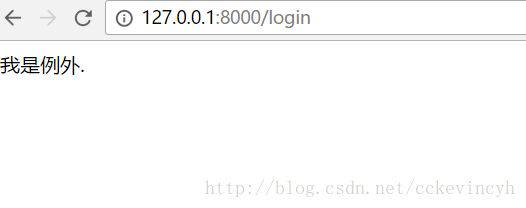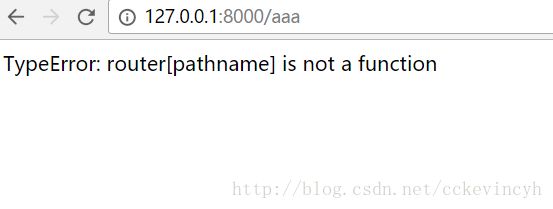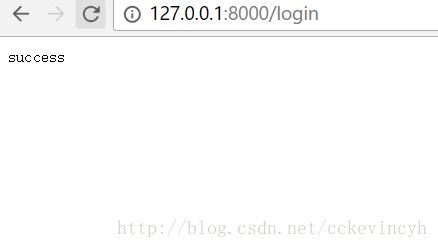Node.js 异常处理
var http = require('http');
var url = require('url');
var router = require('./router');
http.createServer(function(request,response){
if(request.url != '/favicon.ico'){
var pathname = url.parse(request.url).pathname;
pathname = pathname.replace(/\//,''); //替换掉前面的'/'
console.log("Request for " + pathname + " received.");
router[pathname](request,response);
}
}).listen(8000);
console.log('Server running at http://127.0.0.1:8000');我们之前的项目中,如果我们去调用router[pathname](request,response);并且访问一个不存在的pathname,那么我们的程序就会报错。为了避免,我们可以使用try和catch来捕获异常。
var http = require('http');
var url = require('url');
var router = require('./router');
http.createServer(function(request,response){
if(request.url != '/favicon.ico'){
var pathname = url.parse(request.url).pathname;
pathname = pathname.replace(/\//,''); //替换掉前面的'/'
console.log("Request for " + pathname + " received.");
try{
router[pathname](request,response);
}catch(err){
console.log("error:" + err);
response.writeHead(200,{'Content-Type' : 'text/html; charset=UTF-8'});
response.write(err.toString());
response.end('');
}
}
}).listen(8000);
console.log('Server running at http://127.0.0.1:8000');router.js
var optfile = require('./fs_read');
function getRecall(req,res){
function recall(data){
res.writeHead(200,{'Content-Type' : 'text/html; charset=UTF-8'});
res.write(data);
res.end('');
}
return recall;
}
module.exports = {
login : function(req,res){
recall = getRecall(req,res);
optfile.readfile('login.html',recall);
},
register : function(req,res){
recall = getRecall(req,res);
optfile.readfile('register.html',recall);
},
showImg : function(req,res){
res.writeHead(200,{'Content-Type' : 'image/jpeg'});
optfile.readImg('./1.png',res);
}
}如果我们的错误异常出现在router.js的login方法中,在readfile中读取一个不存在的文件,我们是否还能捕获异常呢?
我们修改router.js如下:
var optfile = require('./fs_read');
function getRecall(req,res){
function recall(data){
res.writeHead(200,{'Content-Type' : 'text/html; charset=UTF-8'});
res.write(data);
res.end('');
}
return recall;
}
module.exports = {
login : function(req,res){
recall = getRecall(req,res);
optfile.readfile('login1.html',recall);//修改为不存在的文件
},
register : function(req,res){
recall = getRecall(req,res);
optfile.readfile('register.html',recall);
},
showImg : function(req,res){
res.writeHead(200,{'Content-Type' : 'image/jpeg'});
optfile.readImg('./1.png',res);
}
}再重新访问:

程序执行完毕,但浏览器一直在等待响应,因为在login中的readfile方法中就出现异常了,程序走进了if(err),所以程序没有进行response.end()结束。
var fs = require("fs");
module.exports = {
readfileSync : function(path){//同步读取
var data = fs.readFileSync(path,'utf-8');
console.log(data);
console.log("同步方法执行完毕");
},
readfile : function(path,recall){//异步执行
fs.readFile(path,function(err,data){
if(err){
console.log(err);
}else{
recall(data); //回调recall函数,它是闭包函数,它会存储原来的response对象
console.log(data.toString());
}
});
console.log("异步方法执行完毕");
},
readImg : function(path,res){
fs.readFile(path,'binary',function(err,file){
if(err){
console.log(err);
return ;
}else{
res.write(file,'binary');
res.end();
}
});
}
}因为在readfile 中的调用的fs.readFile()中的事件回调的第一个参数就是err,当读取文件出现错误的时候,就会放入err参数中,最后被打印出来了。所以异常就在这个地方报来了。
我们进行如下修改:
var fs = require("fs");
module.exports = {
readfileSync : function(path){//同步读取
var data = fs.readFileSync(path,'utf-8');
console.log(data);
console.log("同步方法执行完毕");
},
readfile : function(path,recall){//异步执行
fs.readFile(path,function(err,data){
if(err){
console.log(err);
recall("文件不存在");
}else{
recall(data); //回调recall函数,它是闭包函数,它会存储原来的response对象
console.log(data.toString());
}
});
console.log("异步方法执行完毕");
},
readImg : function(path,res){
fs.readFile(path,'binary',function(err,file){
if(err){
console.log(err);
return ;
}else{
res.write(file,'binary');
res.end();
}
});
}
}这样就解决了一直浏览器等待响应的问题,在调用recall()方法中执行了end()方法。
总结:在同步的代码中,可以使用try、catch捕获异常,但是在异步的代码中,try、catch是捕获不到异步中的异常,通常是通过异步代码中的事件回调中的error参数进行捕获异常的。
下面我们来讲讲异常的抛出:
我们利用之前的代码写一个例子:
module_expection.js
module.exports = {
expfun : function(flag){
if(flag == 0){
throw '我是例外.';
}
return "success";
}
}var http = require('http');
var url = require('url');
var router = require('./router');
var exception = require('./module_exception');
http.createServer(function(request,response){
if(request.url != '/favicon.ico'){
var pathname = url.parse(request.url).pathname;
pathname = pathname.replace(/\//,''); //替换掉前面的'/'
console.log("Request for " + pathname + " received.");
try{
data = exception.expfun(1);
response.write(data);
response.end('');
}catch(err){
console.log("error:" + err);
response.writeHead(200,{'Content-Type' : 'text/html; charset=UTF-8'});
response.write(err.toString());
response.end('');
}
}
}).listen(8000);
console.log('Server running at http://127.0.0.1:8000');var http = require('http');
var url = require('url');
var router = require('./router');
var exception = require('./module_exception');
http.createServer(function(request,response){
if(request.url != '/favicon.ico'){
var pathname = url.parse(request.url).pathname;
pathname = pathname.replace(/\//,''); //替换掉前面的'/'
console.log("Request for " + pathname + " received.");
try{
data = exception.expfun(0);
response.write(data);
response.end('');
}catch(err){
console.log("error:" + err);
response.writeHead(200,{'Content-Type' : 'text/html; charset=UTF-8'});
response.write(err.toString());
response.end('');
}
}
}).listen(8000);
console.log('Server running at http://127.0.0.1:8000');上面我们传入一个异常的数据

而且后台输出

因为throw出来的异常被try、catch捕获到了。
这就是异常抛出throw 的作用,可以将异常向上层抛出,让上层代码进行捕获,实现异常消息的传递。





